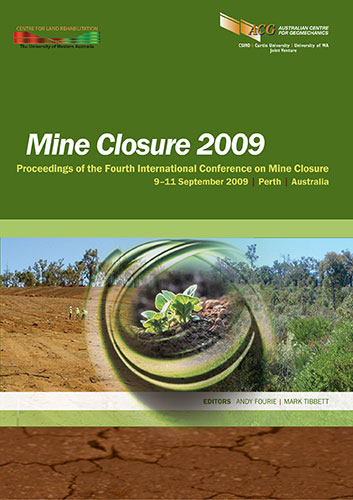Striving for ‘walk-away’ — focusing an expert group on the ‘holy grail’ of mine closure

|
Authors: McLeary, MB |
DOI https://doi.org/10.36487/ACG_repo/908_27
Cite As:
McLeary, MB 2009, 'Striving for ‘walk-away’ — focusing an expert group on the ‘holy grail’ of mine closure', in AB Fourie & M Tibbett (eds), Mine Closure 2009: Proceedings of the Fourth International Conference on Mine Closure, Australian Centre for Geomechanics, Perth, pp. 359-373, https://doi.org/10.36487/ACG_repo/908_27
Abstract:
Leading practice ‘mine closure’ is now integral to mine planning from inception. However, in an historic site there is limited opportunity to gain site knowledge and integrate closure planning throughout the life of the mine. Acid metalliferous drainage (AMD) at Brukunga Mine, 90 minutes east of Adelaide, South Australia, is a significant long-term environmental issue as a consequence of pyrite mining – with the site now comprising two large waste rock dumps, a tailings dam, mine benches and voids, all containing sulphidic material. Past and current predictions are that generation of AMD could require ongoing treatment for 300 to 1,000 years. The South Australian Government has managed this site since 1977 and costs are approximately A$1 m per annum. The Department of Primary Industries and Resources South Australia (PIRSA) is currently implementing a process for determining the most effective long-term solution for site remediation. A review of the current mine management strategy was undertaken in 2007, resulting in the development of the Brukunga Mine Forward Program, comprising six phases. Phase 1 included the establishment of a technical advisory group (TAG), tasked with recommending (to Government) the most effective technical ‘walk-away’ remediation solution for Brukunga Mine. The TAG provides some 125 years of combined national and international experience specialising in geochemistry and water treatment; geotechnical aspects and soil covers; and remediation options and costing1. The group developed potential ‘walk-away’ remediation solutions by functioning under a guided self-management model. This model incorporated shared information, shared decision-making, application of selected expertise across different companies/agencies, and group developed models to generate creative and holistic solutions to complex problems. The TAG operated independently but under overarching guidance applying a variety of technologies and process strategies including meeting in workshops, online, on-site and in teleconference environments at frequent intervals. Validation of the TAG process and guided self management model, is demonstrated by an agreed notion that ‘walk-away’ remediation is realistic and achievable, by delivering a preferred ‘walk-away’ remediation option to Government and thereby ensuring commencement of Phase 2 (testing, feasibility of the option) of the Forward Program. The focus of this paper is to illustrate the process by which the TAG functioned and developed such a ‘walk-away’ solution at Brukunga Mine. Ultimately, committing to and implementing any ‘walk-away’ remediation of AMD at Brukunga Mine rests with future Government.
References:
Australian Nuclear Science and Technology Organisation (ANSTO) (1994) Oxidation rates in waste rock dumps and
the tailings dam at Brukunga: A report to Environmental Geochemistry International Pty Ltd, ANSTO/C384,
Sydney, Internal Report (unpublished).
Department of Industry Tourism and Resources (DITR) (2006) Mine Closure and Completion: Leading Practice
Sustainable Development Program for the Mining Industry, Australian Government Department of Industry
Tourism and Resources, Commonwealth of Australia, Canberra.
Environment Australia (EA) (1999) Environmental Risk Management: Best Practice Environmental Management in
Mining, June, Environment Protection Agency, Canberra, p. 9.
Primary Industries and Resources of South Australia (PIRSA) (2001) Brukunga Mine Site Rehabilitation Rock Dump
Relocation, Primary Industries and Resources of South Australia, South Australian Government, Adelaide,
Report (unpublished).
© Copyright 2026, Australian Centre for Geomechanics (ACG), The University of Western Australia. All rights reserved.
View copyright/legal information
Please direct any queries or error reports to repository-acg@uwa.edu.au
View copyright/legal information
Please direct any queries or error reports to repository-acg@uwa.edu.au